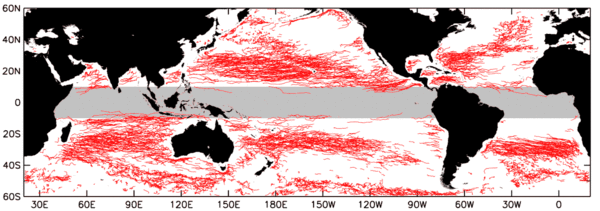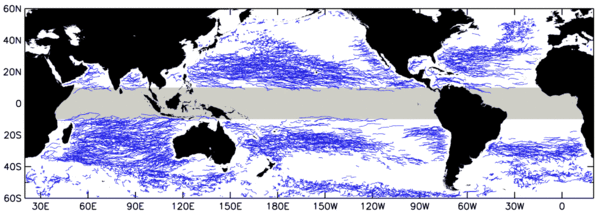Altimetry on eddies' tracks
Image of the month - September 2007
Anticyclonic (top) and cyclonic (bottom) eddies with lifetimes longer than 18 weeks tracked from altimetry data. Both kinds are moving westwards, with respectively a slight (less than 10°) equatorward and a slight poleward tendency. Some regions see more anticyclonic eddies (e.g. West of Central America, the Tehuantepec and Papagayo eddy area), others more cyclonic eddies (e.g. Humbold current, along the Pacific coasts of South America). In the most active regions, like the Gulf Stream, the eddies lifespan are often quite short, and thus relatively few of them appear on the figures.
(Credits Oregon State University)
We often showed in these pages eddies in specific areas. What about the global picture? Where are there eddies, are there areas without them?
Analysis of Sea Level Anomalies from merged satellite data, now available for more than ten years, reveals the areas of high eddy activity, the number of eddies during those years, their size and height. Such a census helps understand ocean dynamics due to features of such size as eddies, and to discriminate eddies'effect from other processes (like the Rossby waves). Some regions see more anticyclonic eddies (positive sea level anomalies), like the Tehuantepec and Papagayo eddy area (see Image of the Month, June 2006 Tehuantepec eddies), others more cyclonic eddies, like the Humbold current.
The higher resolution afforded by the merging of data from several altimetry satellite is essential to study and understand features such as the eddies, with diameters about 100 to 300 km (whereas the distance between two Jason-1 tracks at the Equator is 315 km). Thus the existence of at least two altimetry satellites in working order is needed for such research. For operational applications, three, or even better, four, operational satellites are required.
See also:
- Image of the Month, May 2005: Warm and cold eddies part ways.
- Applications: Ocean circulation and its variations
- Data: Ssalto/Duacs
References:
- Chelton, D. B., M. G. Schlax, R. M. Samelson, and R. A. de Szoeke, Global observations of large oceanic eddies. Geophys. Res. Lett., 34, L15606, doi:10.1029/2007GL030812, 2007






